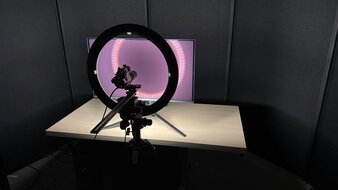
The gaming monitor market is continuously growing, with plenty of options to choose from. There are different factors you'll have to consider when looking for a new gaming monitor, like the refresh rate and resolution. There's no perfect solution for everyone with these, and you have to consider the types of games you play. For example, competitive PC gamers may prefer higher refresh rates and lower resolutions, or you may want a 4k monitor with high-bandwidth ports for more detailed games. There are even high-resolution, high-refresh-rate displays available, but you need a premium gaming setup to take full advantage of them.
We put each monitor through extensive testing that includes thousands of measurements to help you make a buying decision. No matter what type of gamer you are, getting a monitor with a fast response time for great motion handling is beneficial. Low input lag is also important, but that's the case with most monitors. Having VRR support helps reduce screen tearing, and most monitors support common VRR formats. Lastly, premium monitors usually combine their high-end performance with premium picture quality, with deep blacks, bright highlights, and vivid colors. Even some entry-level monitors have good picture quality, but these are less common.
We've bought and tested over 365 monitors, and below, you'll find our recommendations for the best gaming monitors available. See our picks for the best monitors, the best 240Hz monitors, and the best monitor brands. If you want to complete your gaming setup, also check out the best gaming mouse, the best gaming keyboards, and the best gaming headsets.
Quick Look





Best Gaming Monitor
 PC Gaming9.1Console Gaming9.4Response Time9.9HDR Picture9.4SDR Picture10Brightness7.2Size27"Text Clarity9.0Max Refresh Rate240 HzSee all our test resultsNative Resolution3840 x 2160
PC Gaming9.1Console Gaming9.4Response Time9.9HDR Picture9.4SDR Picture10Brightness7.2Size27"Text Clarity9.0Max Refresh Rate240 HzSee all our test resultsNative Resolution3840 x 2160The best gaming monitor we've tested is the ASUS ROG Swift OLED PG27UCDM. It's a premium 4k, 240Hz monitor with a QD-OLED panel. It provides both outstanding picture quality and fantastic gaming performance. Motion looks extremely clear thanks to its near-instantaneous response time, so there's almost no blur behind fast-moving objects. It also supports HDMI and DisplayPort 2.1 bandwidth to take full advantage of modern graphics cards and consoles. Plus, it has some neat extra features like Dolby Vision support, a USB-C port that supports DisplayPort Alt Mode, and a KVM switch.
Its QD-OLED panel delivers perfect blacks in dark rooms without any haloing around bright objects, and colors are vivid. It also gets bright enough to fight most glare in most well-lit rooms, but keep in mind that in bright rooms, deep blacks appear purple. Lastly, it has a 27-inch screen with high pixel density for sharp image clarity, but if you want a bigger 32-inch screen, you can check out the ASUS ROG Swift OLED PG32UCDM instead. It performs very similarly but lacks DisplayPort 2.1 bandwidth and has slightly higher input lag.
Best Upper Mid-Range Gaming Monitor
 PC Gaming9.2Console Gaming9.1Response Time9.8HDR Picture9.5SDR Picture10Brightness7.2Size27"Text Clarity7.0Max Refresh Rate360 HzSee all our test resultsNative Resolution2560 x 1440
PC Gaming9.2Console Gaming9.1Response Time9.8HDR Picture9.5SDR Picture10Brightness7.2Size27"Text Clarity7.0Max Refresh Rate360 HzSee all our test resultsNative Resolution2560 x 1440If you don't need a premium option with a high 4k resolution like the ASUS ROG Swift OLED PG27UCDM, check out the lower-end ASUS ROG Strix OLED XG27ACDNG instead. The main difference is that it has a lower 1440p resolution, so images aren't as detailed, and text isn't as sharp. That said, it has a higher 360Hz refresh rate that's ideal for competitive gaming, and the lower resolution makes it easier for your graphics card to maintain high frame rates.
Besides that, and the fact that it doesn't support Dolby Vision like the PG27UCDM, it's very similar in terms of features. It also has a KVM switch, USB hub, and HDMI 2.1 bandwidth to take full advantage of modern gaming consoles, but it doesn't have DisplayPort 2.1 bandwidth. It also performs similarly, with bright and vivid colors to go alongside sharp motion. Plus, it has deep and inky blacks in dark rooms, but like any QD-OLED, blacks look purple in bright rooms, so you need to use it in the dark to get the best out of it.
Best Mid-Range Gaming Monitor
 PC Gaming9.0Console Gaming8.3Response Time9.9HDR Picture9.0SDR Picture9.9Brightness7.5Size27"Text Clarity6.5Max Refresh Rate240 HzSee all our test resultsNative Resolution2560 x 1440
PC Gaming9.0Console Gaming8.3Response Time9.9HDR Picture9.0SDR Picture9.9Brightness7.5Size27"Text Clarity6.5Max Refresh Rate240 HzSee all our test resultsNative Resolution2560 x 1440If you prefer saving money and don't need a premium OLED, look into the ASUS ROG Strix OLED XG27AQDMG. It's another step-down model from the ASUS ROG Swift OLED PG27UCDM and the ASUS ROG Strix OLED XG27ACDNG, so there are a few notable trade-offs with getting the cheaper monitor. First, it has a lower refresh rate than the XG27ACDNG, so it doesn't feel as smooth. It also doesn't support HDMI 2.1 bandwidth. It lacks some features the higher-end ASUS monitors have, like a KVM switch, but this doesn't impact the gaming performance.
It's still a fantastic gaming monitor with the same sharp motion and low input lag as the higher-end monitors. It also has great picture quality with deep blacks in dark rooms and no haloing around bright objects. Plus, blacks don't look purple in bright rooms like on the QD-OLEDs mentioned above, and it maintains low black levels in bright environments. However, its colors are less vivid than the XG27ACDNG's.
Best Budget Gaming Monitor
 PC Gaming8.2Console Gaming7.4Response Time8.5HDR Picture8.0SDR Picture8.2Brightness8.3Size27"Text Clarity7.5Max Refresh Rate180 HzSee all our test resultsNative Resolution2560 x 1440
PC Gaming8.2Console Gaming7.4Response Time8.5HDR Picture8.0SDR Picture8.2Brightness8.3Size27"Text Clarity7.5Max Refresh Rate180 HzSee all our test resultsNative Resolution2560 x 1440As you get into budget monitors, you get fewer features than with high-end models, but some still offer good gaming performance and picture quality. That's the case with the AOC Q27G3XMN, one of the few low-cost monitors with Mini LED backlighting. Although it doesn't have the same perfect blacks as the ASUS ROG Strix OLED XG27AQDMG, it still combines its high native contrast with its good local dimming feature, so it displays deep blacks next to bright highlights without much haloing, either. It also gets very bright, so highlights pop against the rest of the image, which helps provide good HDR picture quality.
However, there are a few trade-offs versus the ASUS, which is what you can expect from a budget monitor. While it has a fast response time, it has some black smearing, which is one of the downsides of its VA panel. It doesn't have HDMI 2.1 bandwidth to take full advantage of modern gaming consoles, but it's still a great choice for most gamers. You can also look into the AOC Q27G40XMN if you want something brighter and with a better local dimming system. However, it has worse motion handling.
Best Cheap Gaming Monitor
 PC Gaming6.9Console Gaming6.1Response Time7.4HDR Picture4.9SDR Picture5.8Brightness7.1Size27"Text Clarity7.0Max Refresh Rate170 HzSee all our test resultsNative Resolution2560 x 1440
PC Gaming6.9Console Gaming6.1Response Time7.4HDR Picture4.9SDR Picture5.8Brightness7.1Size27"Text Clarity7.0Max Refresh Rate170 HzSee all our test resultsNative Resolution2560 x 1440If you're finding the AOC Q27G3XMN too expensive and are looking for something cheaper, check out the MSI G274QPF-QD. It has the same 1440p resolution as the AOC and similar brightness in SDR. It also has a few advantages over the AOC, as you can connect this monitor to your PC over USB-C, and it doesn't have any smearing with fast-moving objects, though overall, its motion handling is worse.
However, the HDR performance of these two monitors differs considerably. The MSI doesn't have a local dimming system, so deep blacks appear gray in a dark room, and it doesn't get bright enough for highlights to pop. Additionally, its HDR colors are less vivid, though it displays a wide range of colors for a cheap display. While its HDR performance is lacking, it's a great low-cost option if you don't plan on using HDR.
Notable Mentions
- Dell Alienware AW2725Q:
The Dell Alienware AW2725Q is a 4k, 240Hz QD-OLED that's a cheaper alternative to the ASUS ROG Swift OLED PG27UCDM. It performs similarly but has fewer features, as it lacks DisplayPort 2.1 bandwidth and a KVM switch. That said, it's still worth considering if you don't need the features on the ASUS.
See our review - Gigabyte AORUS FO27Q3:
The Gigabyte AORUS FO27Q3 competes with the ASUS ROG Strix OLED XG27ACDNG and performs similarly. You can't go wrong with either monitor, especially if you can find them at the same price, but the Gigabyte can sometimes be harder to find.
See our review - LG 27GX790A-B:
The LG 27GX790A-B is a 1440p gaming monitor with a higher refresh rate than the ASUS ROG Strix OLED XG27ACDNG. It's something to consider if you'll take advantage of a high 480Hz refresh rate, but it has less vivid colors.
See our review - BenQ MOBIUZ EX321UX:
The BenQ MOBIUZ EX321UX is a 4k, 144Hz Mini LED monitor that's something to consider in the upper mid-range price category if you want something brighter than the ASUS ROG Strix OLED XG27ACDNG. Highlights really pop, but it doesn't display the same deep blacks as an OLED and has a lower refresh rate than the ASUS.
See our review
Recent Updates
Aug 15, 2025:
We replaced the Dell G2524H with the MSI G274QPF-QD, as it gets much brighter, displays a wider range of colors, and has a higher resolution. We also removed the ASUS ROG Swift OLED PG32UCDM from the Notable Mentions.
Jul 14, 2025:
We replaced the MSI MPG 271QRX QD-OLED with the ASUS ROG Strix OLED XG27ACDNG because the MSI is hard to find. We also replaced the Acer Nitro XV275K P3biipruzx with the ASUS ROG Strix OLED XG27AQDMG, which has a higher refresh rate and better motion handling. Lastly, we replaced the XG27ACDNG and the Sony INZONE M10S with the LG 27GX790A-B and the BenQ MOBIUZ EX321UX in the Notable Mentions.
May 23, 2025:
We replaced the MSI MPG 321URX QD-OLED with the ASUS ROG Swift OLED PG27UCDM for consistency with other recommendations, as the ASUS has a few extra features. We also added the Dell G2524H as the 'Best Cheap Monitor' to give another option. Lastly, we replaced the Dell Alienware AW3225QF with the Dell Alienware AW2725Q in the Notable Mentions.
Apr 02, 2025:
We removed the LG 27GP850-B/27BP83B-B because it's hard to find. We also replaced the ASUS ROG Strix XG27ACS with the ASUS ROG Strix OLED XG27ACDNG in the Notable Mentions.
Feb 19, 2025:
We replaced the Dell G2724D with the LG 27GP850-B/27GP83B-B because the Dell is hard to find. We also replaced the LG 32GS95UE-B with the Sony INZONE M10S in the Notable Mentions, as the Sony is cheaper. We introduced a new format to the article and updated the text to reflect these changes.
All Reviews
Our recommendations are based on what we think are the best monitors for gaming on PCs and consoles currently available. They are adapted to be valid for most people in each price range. The rating is based on our review, factoring in price and feedback from our visitors.
If you'd prefer to make your own decision, here's the list of all of our monitor reviews. Be careful not to get too caught up in the details. Most monitors are good enough to please most people, and the things we fault monitors on are often not noticeable unless you really look for them.
Comments
Best Gaming Monitors: Main Discussion
What do you think of our picks? Let us know below.
Looking for a personalized buying recommendation from the RTINGS.com experts? Insiders have direct access to buying advice on our insider forum.
Update: Added link to the Epson WorkForce WF-2950 in the ‘Scanner Features’ section of the review to provide an alternative with better scan quality.










































































